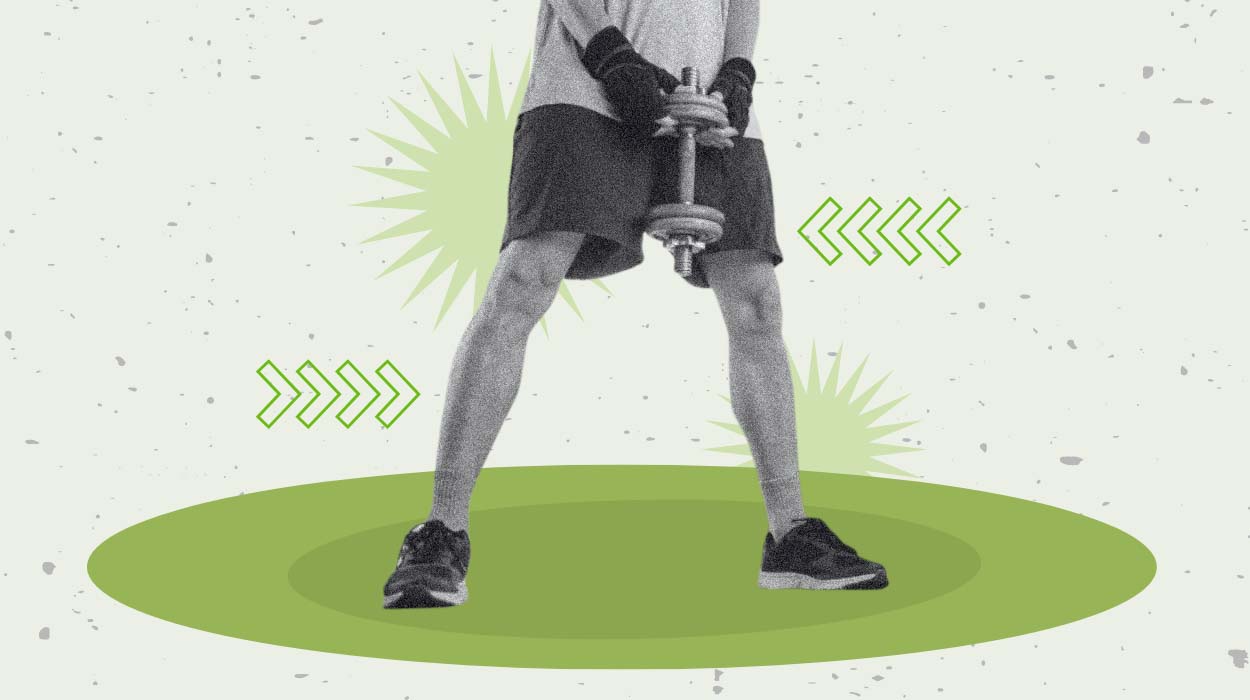
We all know that developing a strong lower body is essential for total body fitness. But when it comes to leg day, you either love it or hate it. Some people are counting down the minutes until the next time that they can get a killer leg workout, while others have to drag themselves to the gym and force themselves to do it. No matter which side you take, we all depend on our leg strength to get us places: climbing stairs, walking the dog, getting up from the floor, running, biking, hiking, and so much more.
If the gym is super crowded or you don’t have time to go at all and all you have at your disposal is a pair of dumbbells, then we’ve got you covered. We’ve gathered the best leg workouts with dumbbells that are simple and super effective for lower-body muscle development. Let’s see what is the best dumbbell leg workout for you!
Best Dumbbell Leg Exercises
These dumbbell leg exercises are compound lifts that build defined legs and are easy to do almost anywhere. Dumbbell goblet squats
- Dumbbell sumo squats.
- Dumbbell Romanian deadlift.
- Dumbbell jump squats.
- Dumbbell single-leg deadlift.
- Dumbbell reverse lunges.
- Dumbbell Bulgarian split squats.
- Dumbbell calf raises.
Be sure that you support your efforts with a mobility routine, protein, and sleep.
Dumbbell Leg Workout: Best Leg Exercises With Dumbbells
There are numerous muscles in our legs. By including some or all of the following leg exercises with dumbbells in your next session, you will be targeting the most important ones for ultimate lower body strength.
Dumbbell Goblet Squat
The Dumbbell Goblet Squat is a highly effective lower-body strength and conditioning exercise. It involves holding a dumbbell close to your chest while performing a squat, which not only targets your quadriceps, hamstrings, and glutes but also engages your core and upper body. This exercise is popular among fitness enthusiasts for its ability to improve overall lower body strength and stability.
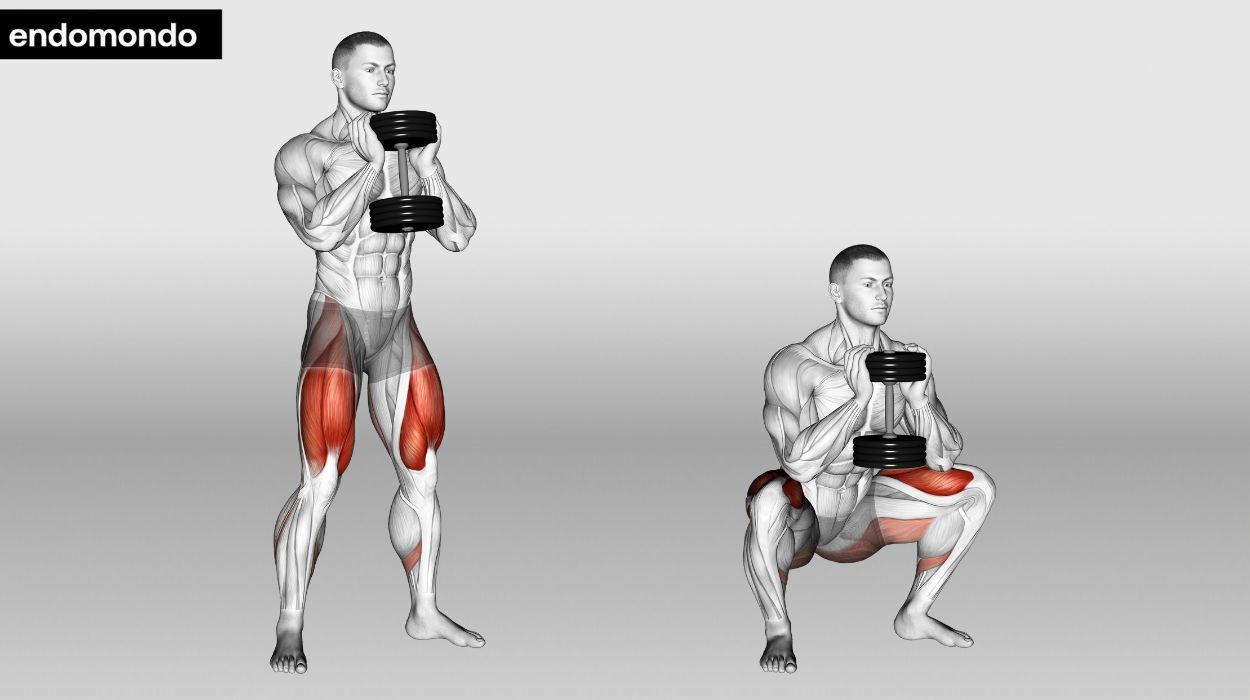
How to do:
- Begin in a standing position with one dumbbell held in both hands at your chest and your feet slightly wider than hip-width.
- Squat down until your thighs are about parallel to the floor.
- Press through both legs to return to the starting position.
- Use your core strength to try to keep your torso upright as you perform the goblet squat.
Tips:
- Focus on proper breathing by inhaling as you lower into the squat and exhaling as you push back up, helping stabilize your core and maintain control.
- Use a dumbbell or kettlebell with a comfortable grip and ensure it’s close to your chest during the exercise to promote balance and stability.
- To deepen the squat and engage your muscles more, aim to lower yourself until your thighs are parallel to the ground or as low as your mobility allows without compromising form.
Optimal Sets and Reps: 3 sets of 10-12 reps.
Dumbbell Sumo Squat
The Dumbbell Sumo Squat is a powerful lower-body exercise that adds variation to your squat routine. In this exercise, you perform a deep squat, targeting your inner thighs, quadriceps, and glutes for a comprehensive lower-body workout.
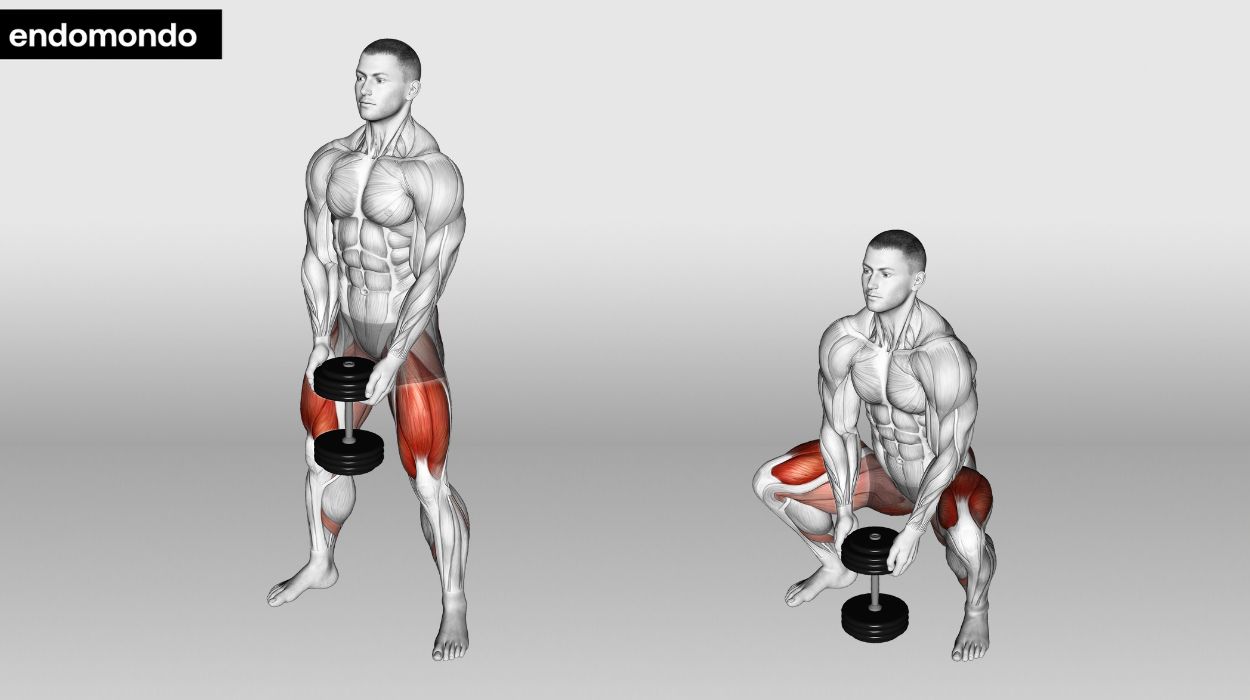
How to do:
- Grab a dumbbell and hold it with both hands with your arms straight down in front of you.
- Your feet should be wider than hip width and your toes pointed slightly outward.
- Bend your knees and squat down until your thighs are parallel to the floor then press to come back up to the starting position.
- When doing sumo squats, try to lower the dumbbell to the floor right in the middle of your feet, all while keeping your back straight.
Tips:
- Maintain a wide stance and point your toes slightly outward to ensure proper Sumo Squat form.
- Keep your chest up, shoulders back, and core engaged throughout the exercise to maintain good posture.
- Lower yourself into the squat in a controlled manner, avoiding quick drops to prevent strain.
Optimal Sets and Reps: 3 sets of 10-12 reps.
Dumbbell Romanian Deadlift
The Dumbbell Romanian Deadlift, also known as the Dumbbell RDL, is a compound exercise that focuses on strengthening the posterior chain muscles, including the hamstrings, glutes, and lower back. Incorporating Dumbbell Romanian Deadlifts into your workout routine can help improve both strength and flexibility in your lower back and legs.
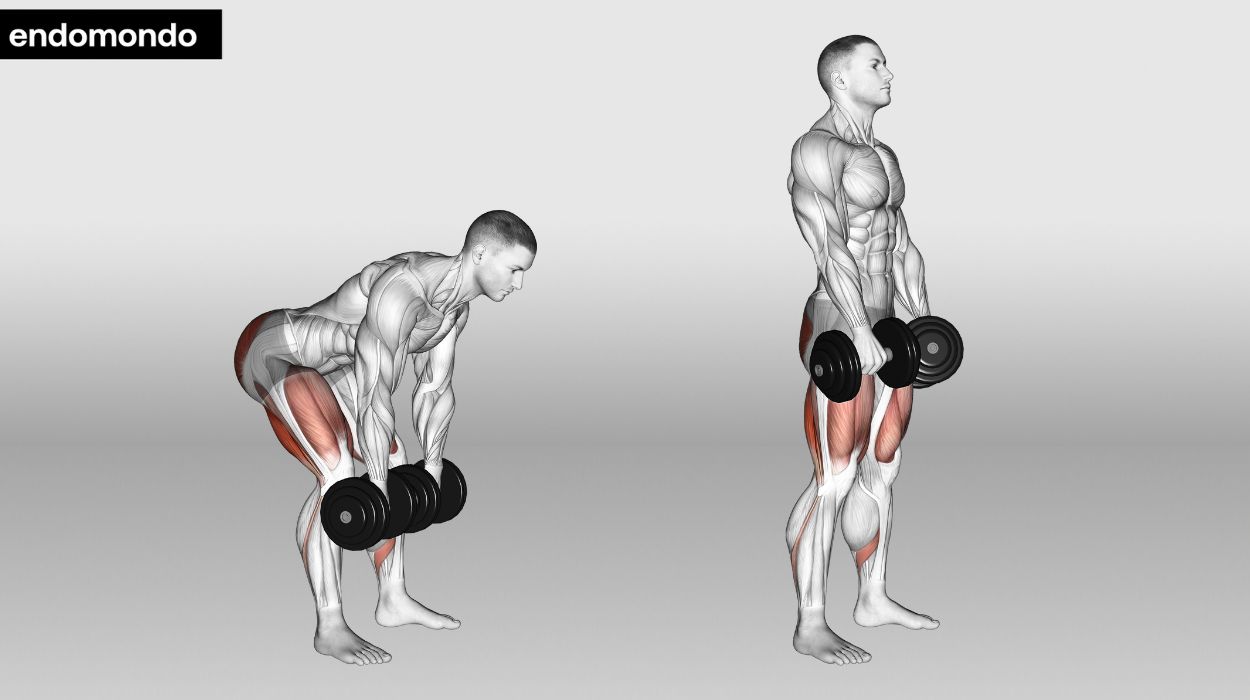
How to do:
- Stand tall holding a dumbbell in each hand with your knees slightly bent, feet hip-width apart and toes pointing forward.
- Bend forward only at the hips and trace the front of your legs with the dumbbells.
- Imagine that you are trying to close a door with your hips; they should move slightly backward.
- Pull your shoulder blades together to help keep your spine straight as you are bending forward.
Tips:
- Maintain a slight natural arch in your lower back, avoiding excessive rounding or hyperextension, to protect your spine.
- Keep a neutral head position, looking straight ahead or slightly downward, to maintain proper spinal alignment.
- Perform in a controlled manner, emphasizing the eccentric (lowering) phase of the exercise to maximize muscle engagement and reduce the risk of injury.
Optimal Sets and Reps: 3 sets of 8-10 reps.
Dumbbell Jump Squats
This is like a standard dumbbell squat, but a little harder!
Dumbbell Jump Squats are a dynamic plyometric exercise that combines the benefits of squatting and explosive jumping movements. Dumbbell Jump Squats are an excellent way to enhance lower body power, coordination, and cardiovascular fitness.
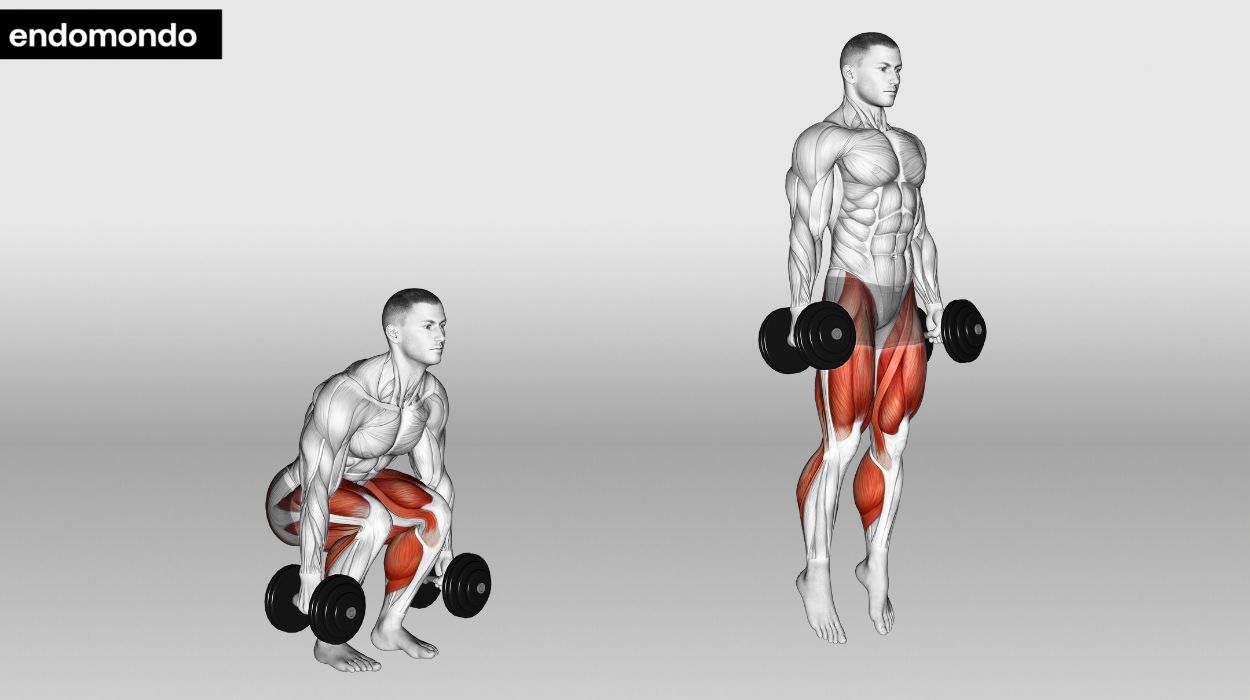
How to do:
- Stand with your feet shoulder-width apart and one dumbbell held in both hands at your chest.
- Squat down to a comfortable depth, then press through your legs to jump off the ground.
- Land lightly with both legs at the same time and with control.
- You can do these continuously or with a short pause between each rep.
Tips:
- Maintain proper squat form by keeping your chest up, back straight, and knees aligned with your toes.
- Explode upward with power and land softly to reduce the impact on your joints and minimize the risk of injury.
- Start with a light dumbbell weight or body weight to practice the technique, and as you become more proficient, gradually increase the resistance for a more challenging workout.
Optimal Sets and Reps: 3 sets of 8-10 reps.
Dumbbell Single Leg Deadlift
The Dumbbell Single Leg Deadlift is a challenging lower-body exercise that enhances balance, stability, and strength. Dumbbell Single Leg Deadlifts are effective for targeting the hamstrings, glutes, and lower back, and improving overall functional strength.
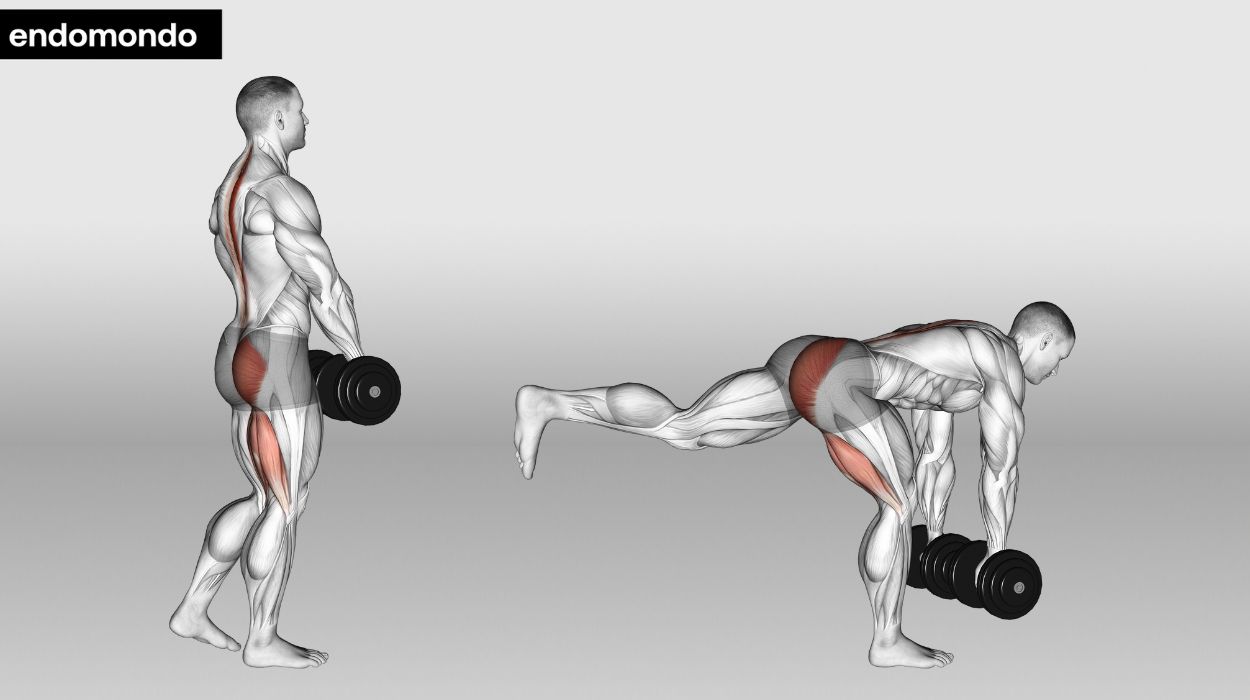
How to do:
- Hold a dumbbell in each hand and balance on just your right leg with your left leg in the air behind you.
- Keep your right leg straight as you lean forward at the hips to lower the weights towards the ground.
- Use your core muscles to keep your spine straight.
- Once the weights are just lower than your knee, return to the starting position.
Tips:
- Focus on a fixed point in front of you to help with balance and stability during the movement.
- Keep your core engaged throughout the exercise to provide additional support for your lower back and maintain proper form.
- Perform the exercise on both legs to maintain balanced strength and stability.
Optimal Sets and Reps: 3 sets of 10-12 reps.
Dumbbell Reverse Lunge
You will feel the front thigh (quads) working the hardest with this exercise.
The Dumbbell Reverse Lunge is a versatile lower-body exercise that helps develop strength, stability, and balance. Dumbbell Reverse Lunges are effective for targeting the quadriceps, hamstrings, and glutes, making them a valuable addition to any leg-focused workout routine.
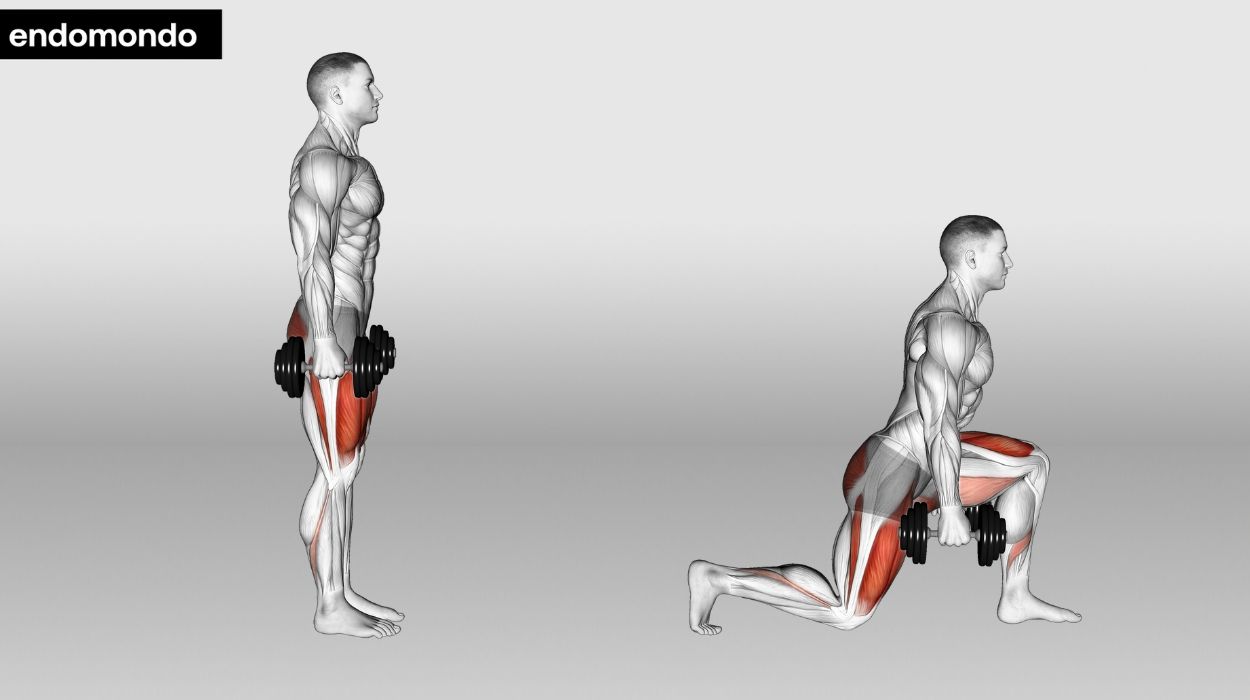
How to do:
- Stand with one dumbbell in each hand and your arms at your sides.
- Your left foot stays in front while you step back with your right foot then lower yourself towards the ground until your front and back knees are both bent to about 90 degrees.
- Press up to the starting position and bring your right foot forward to meet your left.
- You can either do all repetitions on one leg or alternate.
Tips:
- Ensure your front knee remains aligned with your ankle and doesn’t extend past your toes during the lunge to prevent excessive stress on the knee joint.
- As you step back into the lunge, maintain a controlled and slow tempo to maximize muscle engagement and stability.
- Engage your core throughout the exercise to stabilize your spine and enhance overall balance.
Optimal Sets and Reps: 3 sets of 10-12 reps.
Dumbbell Bulgarian Split Squats
Dumbbell Bulgarian Split Squats are a highly effective lower body exercise that targets the quadriceps, hamstrings, and glutes. This exercise helps improve leg strength, balance, and stability, making it a valuable addition to any leg training routine.
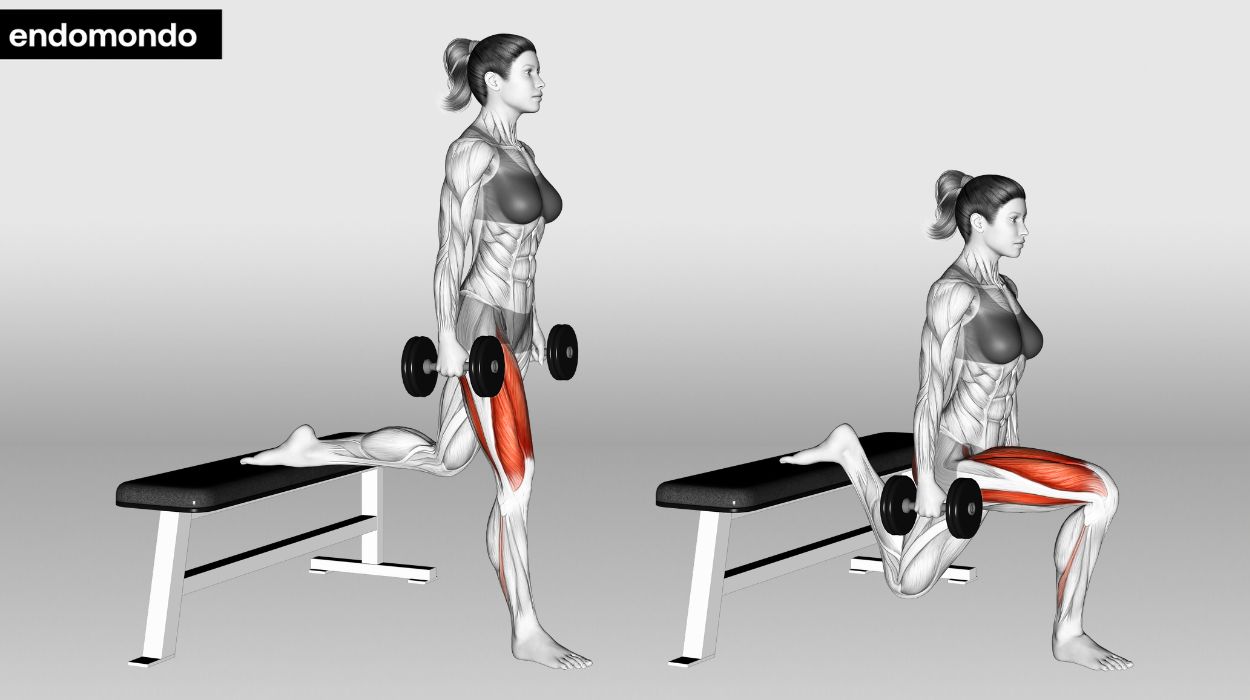
How to do:
- For this exercise, you will need a bench or couch that is just lower than knee height.
- Stand about 12-18 inches in front of it and, with your back facing the couch, place your right foot laces down on the bench, and your left foot on the floor.
- Hold a dumbbell in each hand and bring most of your body weight into your left leg.
- Lower yourself straight towards the ground until your left thigh is about parallel to the floor.
- Your right knee should almost touch the ground.
- Press through your left leg to bring yourself back to the starting position, then repeat for the right leg.
Tips:
- Maintain proper alignment by ensuring your front knee stays above your ankle during the descent to prevent excessive strain on the knee joint.
- Engage your core muscles for added stability and to protect your lower back throughout the exercise.
- Focus on balance and control, lowering yourself in a slow and controlled manner to maximize muscle engagement and minimize the risk of injury.
Optimal Sets and Reps: 3 sets of 8-10 reps.
Dumbbell Calf Raises
Dumbbell Calf Raises are a fundamental exercise designed to target and strengthen the calf muscles, specifically the gastrocnemius and soleus. Dumbbell Calf Raises help to improve calf strength, endurance, and overall lower leg development, making them a valuable addition to your lower body workout routine.
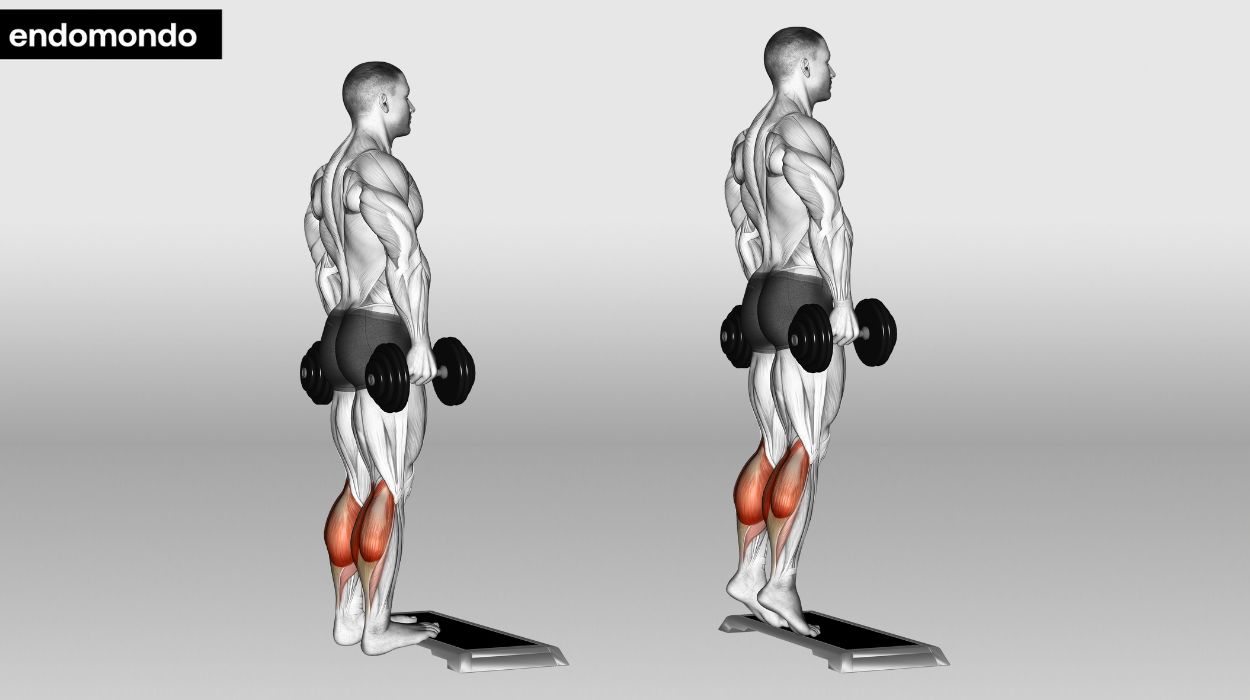
How to do:
- Stand upright with your feet shoulder-width apart and a dumbbell in each hand.
- Press up onto your toes to lift your heels off the ground as high as you can.
- Slowly lower your heels back down to the floor.
Tips:
- Maintain a straight posture with your shoulders back and core engaged throughout the exercise to ensure stability and proper form.
- Focus on controlled movements, both when rising up on your toes and when lowering your heels, to maximize muscle engagement and reduce the risk of injury.
- Gradually increase the weight you use as your calf muscles become stronger to continue progressing in your calf training.
Optimal Sets and Reps: 3 sets of 12-15 reps.
Benefits Of Dumbbell Leg Workout
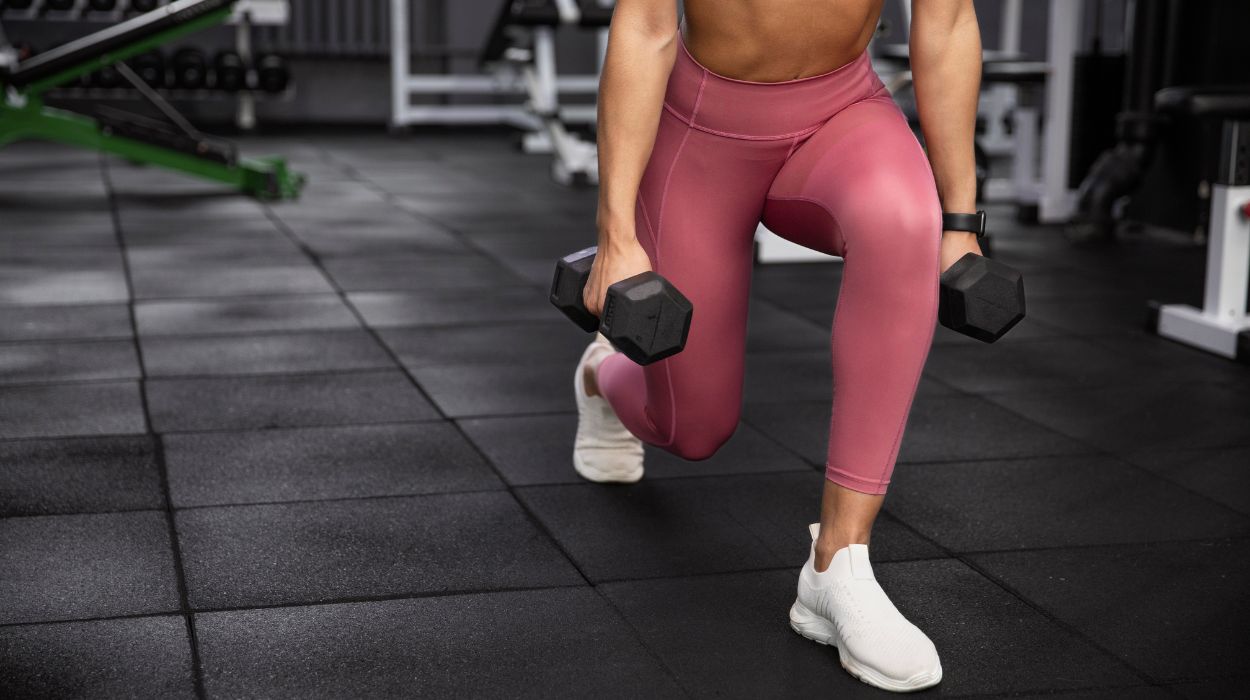
There are many benefits to doing a dumbbell leg workout. They work many muscles at once, they can be done at home or the gym, and they build toned and nicely shaped leg muscles.
- Compound movements: A compound exercise means that 2 or more joints are moving at once. These movements make you work harder by recruiting more muscles to burn more calories and build stronger muscles in the workout.
- Do them anywhere: A pair of dumbbells is easy to store at home and doesn’t require the space that a squat rack does. Both gym and home leg workouts with dumbbells require just a small space with very little equipment.
- Strong legs look and feel good: Toned muscles are something that everyone can admire. It shows dedication and effort and they take time to build. Strength training has been shown to improve feelings of body satisfaction.[1]
Tips For Doing Dumbbell Leg Exercises
Make sure you’re getting the most out of your workouts! You can’t just do some dumbbell lunges, deadlifts, and squats and expect to see results. If you need help building a workout routine, check out our 3-day workout split, 5-day workout split or the famous Arnold split for inspiration. Also, try incorporating some of these tips in your fitness journey to see results faster.
- Mobility routine: Since these movements are compound, this means that many joints need to move correctly. Spine, ankle, and hip mobility are all important to consider when performing a dumbbell leg workout. For example, if you don’t have a good ankle range of motion, this could impact how low you can squat. Consult a personal trainer or physical therapist to check for mobility deficits.
- Get enough protein: With continued weight training, consuming enough protein[2] is important for building muscle. Typically, people should eat 0.8 kg of protein per kilogram of body weight per day. However, when you’re weight training, that demand increases!
- Get plenty of sleep: Sleep science is still an emerging field but many studies[3] are showing the importance of adequate sleep time and its positive impact on helping the body build muscle. This study showed[4] that even one night of sleep deprivation can hurt protein synthesis in the body.
Conclusion
While most leg workouts conventionally use lots of bulky equipment, we’ve compiled the best exercises for getting stronger and more muscular legs using only dumbbells. A dumbbell leg workout allows you to work your muscles harder, do them anywhere, and build higher self-esteem in the process. Make sure you also incorporate mobility, protein, and sleep into your routine as these are vital in your journey.
Frequently Asked Questions
By adding a mobility routine, consuming enough protein, and getting enough sleep, you will be supporting your body’s ability to build strong muscles.
Absolutely. All you need is a couple of dumbbells and a small space to move in. For many people, having dumbbells at home makes it easier to get the workout done!
By bringing the back leg up off the floor you are placing most of the demand on the front leg. You can do this exercise with just your body weight to start until you are comfortable adding weight.
The best time to work out is a personal choice. Some people love a morning workout routine, while others prefer later in the day. You may need some trial and error to find the best time for you, but essentially you will get the best workout when you are most ready to go to the gym.
For beginners, start with smaller weights, probably between 5 and 20 pounds. As you get stronger and become more comfortable with the movements, gradually increase the weight of the dumbbells.
Resources
- SantaBarbara, N.J., Whitworth, J.W. and Ciccolo, J.T. (2017). A Systematic Review of the Effects of Resistance Training on Body Image. The Journal of Strength and Conditioning Research, [online] 31(10), pp.2880–2888. doi:https://doi.org/10.1519/jsc.0000000000002135.
- Pasiakos, S.M., McLellan, T.M. and Lieberman, H.R. (2014). The Effects of Protein Supplements on Muscle Mass, Strength, and Aerobic and Anaerobic Power in Healthy Adults: A Systematic Review. Sports Medicine, [online] 45(1), pp.111–131. doi:https://doi.org/10.1007/s40279-014-0242-2.
- Chen, Y., Cui, Y., Chen, S. and Wu, Z. (2017). Relationship between sleep and muscle strength among Chinese university students: a cross-sectional study. Journal of musculoskeletal & neuronal interactions, [online] 17(4), pp.327–333. Available at: https://www.ncbi.nlm.nih.gov/pmc/articles/PMC5749041/.
- Lamon, S., Morabito, A., Arentson‐Lantz, E., Knowles, O., Vincent, G.E., Condo, D., Alexander, S.E., Garnham, A., Paddon‐Jones, D. and Aisbett, B. (2021). The effect of acute sleep deprivation on skeletal muscle protein synthesis and the hormonal environment. Physiological Reports, [online] 9(1). doi:https://doi.org/10.14814/phy2.14660.




